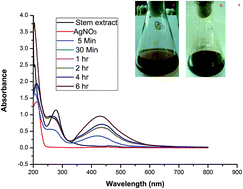Antimicrobial, antioxidant and anticancer activity of biogenic silver nanoparticles – an experimental report†
Abstract
In the present study, use of a Helicteres isora stem bark extract for the biosynthesis of AgNPs is described. It was observed that the aqueous silver (Ag+) ions, once associated in the stem bark extract, were reduced in solution, thereby leading to formation of the stable AgNPs. These AgNPs were characterized using several techniques. The nanoparticles show a maximum absorbance at 419–431 nm in the ultraviolet-visible spectra. The presence of the steroid sapogenin was identified using Fourier transform-infrared (FTIR) spectroscopy. The reduction of the Ag+ ions to elemental silver was investigated by using X-ray diffraction (XRD). Transmission electron microscopy (TEM) revealed the formation of monodisperse, with low polydispersity, nanoparticles of 25.55 nm, and the presence of elemental silver was confirmed through energy dispersive spectroscopy (EDX) analysis. The AgNPs showed antioxidant activities such as DPPH, hydrogen peroxide and nitric oxide radical scavenging and a reducing power compared to the standard compounds. The antibacterial effect was determined against test strains, showing significant inhibition. The antiproliferative activity of the AgNPs was demonstrated using oral carcinoma (KB) cells with MTT, and confirmed using AO/EtBr, comet assay, DCFH-DA and Rhodamine 123 staining. In the toxicity study, a significant mortality rate was observed against Artemia with an IC50 concentration of 70 μg mL−1 and 108 h exposure. The NPs showed as cytotoxic against Artemia at 108 h, so they are cytotoxic at high concentrations and after prolonged exposure.


 Please wait while we load your content...
Please wait while we load your content...